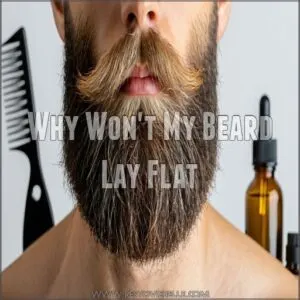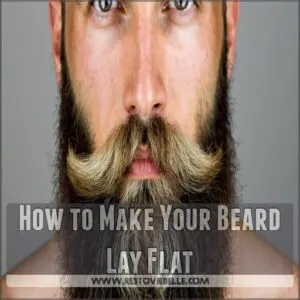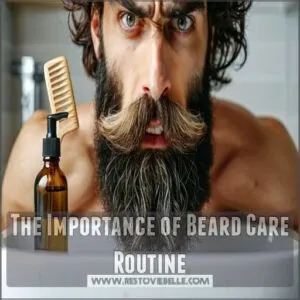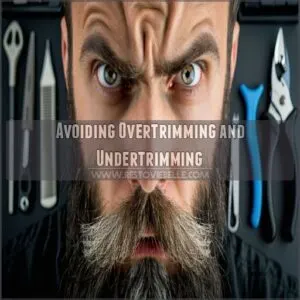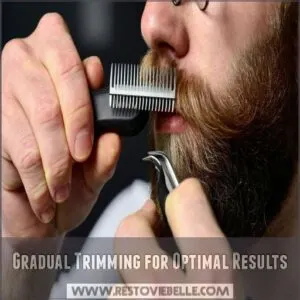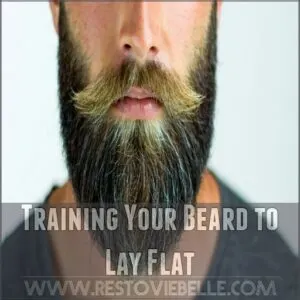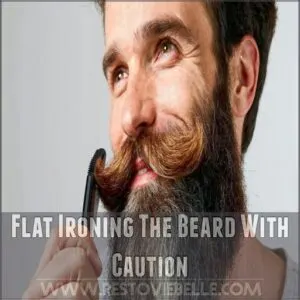This site is supported by our readers. We may earn a commission, at no cost to you, if you purchase through links.
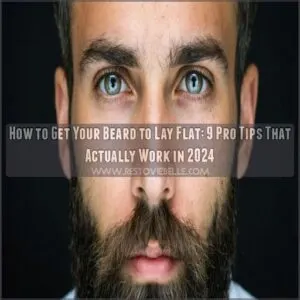 Getting your beard to lay flat isn’t rocket science – it’s all about the right routine.
Getting your beard to lay flat isn’t rocket science – it’s all about the right routine.
Start by washing with a dedicated beard shampoo to remove dirt and oil that make hair unruly.
Apply beard oil while your facial hair is slightly damp, then use a wooden comb to distribute the product evenly.
For stubborn strays, try blow-drying on low heat while combing downward.
Daily maintenance is key: brush in the morning, touch up with a boar bristle brush throughout the day, and apply a light hold balm to keep those rebellious hairs in check.
And that’s just the beginning of your journey to beard mastery.
Table Of Contents
- Key Takeaways
- Why Won’t My Beard Lay Flat
- How to Make Your Beard Lay Flat
- The Importance of Beard Care Routine
- Trimming and Shaping for a Flat Beard
- Training Your Beard to Lay Flat
- Common Beard Trimming Mistakes to Avoid
- Beard Straightening Techniques for a Flat Beard
- Maintaining a Flat Beard With Regular Care
- Advanced Techniques for a Flat Beard
- Frequently Asked Questions (FAQs)
- How to make a beard lay flat?
- How do I keep my beard hair laying flat?
- How do you make a beard lay down?
- Can a long beard lay flat against your skin?
- Why does my beard not lay flat?
- How to make a beard look good?
- Why won’t my beard lay flat?
- How can I flatten my beard?
- How to make a beard flatter?
- How to stop a beard from sticking up?
- Can swimming affect how my beard lays flat?
- Does sleeping position impact beard straightness overnight?
- How does diet influence beard texture?
- Will facial exercises help train beard direction?
- Can stress make my beard more unruly?
- Conclusion
Key Takeaways
- Start with proper cleansing using beard shampoo, then apply beard oil while damp and distribute it with a wooden comb to prevent static and frizz.
- Train your beard through daily maintenance: brush in the morning with a boar bristle brush, apply light hold balm throughout the day, and use a blow dryer on low heat while combing downward for stubborn areas.
- You’ll need to find the right balance between growth and trimming – wait 6-8 weeks before your first trim, then maintain every 4-6 weeks to prevent split ends while allowing enough length for the hair to lay flat.
- Combat unruly growth by avoiding plastic combs that create static, using a microfiber towel to reduce friction when drying, and applying leave-in products that match your beard’s texture and thickness.
Why Won’t My Beard Lay Flat
You’re not alone if your beard looks like it’s trying to escape in different directions, as those unruly hairs can make even the most patient person want to reach for the razor.
Your beard’s rebellious behavior usually comes down to four main culprits: genetics, dryness, static, and improper care techniques.
Static and Frizz Causing Unkempt Beards
Anyone who’s rocked a beard knows the frustration of static and frizz turning your facial masterpiece into a wild mess. Here’s what typically causes those unruly hair moments:
- Synthetic fabrics creating friction when you pull shirts over your head
- Plastic combs generating unwanted static electricity, which can be reduced with a beard brush for static.
- Winter weather and indoor heating systems disrupting your beard’s natural balance
- Excessive towel friction after washing
Dryness and Lack of Moisture
Your unruly beard might be sending an SOS signal for moisture.
When your facial hair gets too dry, it becomes brittle and starts rebelling like a teenager – sticking out in every direction possible.
Without proper hydration, the hair cuticles roughen up, creating that frustrating static and frizz.
Think of your beard like a plant – it needs regular watering (in the form of beard oil or balm) to thrive and behave.
Genetics and Facial Hair Texture
Behind every unruly beard lies a genetic story written in your DNA.
Just like inheriting your grandfather’s eyes or mom’s dimples, beard traits pass down through generations.
Here’s what shapes your facial hair destiny:
- Round follicles produce straight, manageable growth
- Oval follicles create wavy patterns
- Triangular follicles result in tight curls
- Scattered follicle angles determine growth direction
Think of it as your unique beard fingerprint – no two are exactly alike.
Improper Beard Care and Trimming
While genetics play a big part in beard texture, improper care can make even the best beard look like a bird’s nest.
Over-washing strips natural oils, leaving your beard dry and unruly.
Loading up on too many products creates buildup that weighs down hair, while trimming too frequently with dull tools can lead to split ends and stubborn flyaways.
Understanding proper care techniques is half the battle won.
How to Make Your Beard Lay Flat
Getting that beard to lay flat isn’t rocket science – it’s all about using the right combination of techniques and products.
Think of your beard like a garden that needs proper care and attention to flourish.
I’ve helped countless guys transform their wild facial forests into sleek, well-behaved beards, and these methods really work.
By understanding your beard’s unique growth patterns, such as beard hair growth, you can tailor your approach to achieve the best results.
- Start with a warm shower to soften the hair follicles and make them more manageable
- Apply beard oil while your beard is slightly damp to lock in moisture
- Use a beard balm with beeswax for extra hold and control
- Style with a heated beard brush to train the hairs in your desired direction
- Consider using beard weights or cuffs for particularly stubborn areas
Remember, patience is key – you won’t tame those wild hairs overnight, but consistent application of these techniques will give you the polished look you’re after.
The Importance of Beard Care Routine
You can’t expect your beard to behave like a well-trained puppy without establishing a proper care routine that includes washing, conditioning, and regular maintenance.
A consistent beard care routine will transform your wild facial forest into a masterpiece that’ll make other bearded fellows wonder about your grooming secrets.
Washing With a Dedicated Beard Shampoo
Most guys make the rookie mistake of using regular shampoo on their beards – that’s like washing your car with dish soap.
Unlike scalp hair, your beard needs gentle cleansing that won’t strip away natural oils.
Look for beard-specific shampoos with aloe vera, jojoba oil, or argan oil.
Wash your beard 2-3 times weekly to keep it clean without over-drying, and you’ll notice those flyaways starting to behave.
Conditioning and Hydrating The Beard
Dry, brittle beard hair is like trying to tame a wild cactus – it just won’t cooperate.
Your best defense is a solid conditioning routine with the right products for your hair type.
Science shows that proper hydration can transform even the most rebellious beard into something manageable.
- Use beard oil right after showering when your pores are open
- Apply beard butter at night to lock in moisture
- Choose sulfate-free conditioners to prevent stripping natural oils
- Layer products from lightest to heaviest for maximum absorption
Microfiber Towels for Reduced Friction
Rubbing your beard with a regular towel is like taking sandpaper to your face.
Switch to a microfiber towel instead – it’s gentler and helps your beard behave.
Here’s why microfiber makes such a difference:
| Feature | Regular Towel | Microfiber Towel |
|---|---|---|
| Friction | High | Ultra-low |
| Absorption | Moderate | Superior |
| Static | High | Minimal |
| Fiber Size | Coarse | Ultra-fine |
Just pat your beard dry – don’t rub.
Trust me, your facial hair will thank you.
Static-Free Combs and Brushes
Between the countless plastic combs at your local store, you’ll find that wooden combs and natural bristle brushes are your beard’s best friends.
They’re not just fancy alternatives – these tools naturally resist static buildup that makes your beard look like it’s trying to escape your face.
Kent’s handmade wooden combs and Zeus boar bristle brushes are particularly effective at keeping those wild hairs in check.
Trimming and Shaping for a Flat Beard
You’ll need more than just good intentions to tame those stubborn beard hairs that stick out like a rebellious teenager.
Getting your beard to lay flat starts with proper trimming techniques and the right tools,
which will help train those wild whiskers to behave exactly how you want them to.
Finding The Right Trimming Technique
Like a sculptor finding the perfect angle, mastering beard trimming techniques is all about working with your facial hair’s natural growth pattern.
You’ll want to map out your beard’s direction and decide on your ideal shape before diving in with the trimmers.
- Start with clean, dry beard hair for the most precise trim
- Use guard attachments to maintain consistent length
- Trim against the grain for shorter cuts
- Follow the grain for a more natural finish
Avoiding Overtrimming and Undertrimming
Finding that sweet spot between over-trimming and under-trimming your beard can feel like walking a tightrope, and to avoid that, defining your beard neckline is key, considering factors like facial features and beard length when deciding between an angular or rounded neckline as shown in this guide on how to shave neck line, and you need to shape your beard neckline to achieve a balanced look.
Here’s a quick guide to help you nail the perfect trim every time:
| Issue | Warning Signs | Solution |
|---|---|---|
| Over-trimming | Patchy spots | Wait 2-3 weeks between trims |
| Under-trimming | Split ends | Trim every 2-4 weeks |
| Uneven growth | Scraggly look | Follow natural growth lines |
| Neck line too high | Double chin effect | Keep two fingers above Adam’s apple |
| Cheek line too low | Messy appearance | Follow natural cheek curve |
Using Quality Beard Trimmers and Scissors
Armed with quality tools, you’ll transform your unruly beard into a masterpiece.
The right trimmer and scissors make all the difference in achieving that perfectly flat look you’re after.
Here’s what you need for pro-level results:
- A precision beard trimmer with multiple guard lengths (Wahl Groomsman or Philips Norelco Multigroomer)
- Sharp, stainless steel beard scissors for detail work
- A static-free comb to guide your trimming angles
Gradual Trimming for Optimal Results
Once you’ve got your quality tools ready, take a patient approach to trimming.
Start by letting different sections of your beard grow out – you’ll be surprised how longer lengths can naturally weigh down those stubborn hairs.
Think of it like training a plant to grow in a certain direction.
Experiment with various lengths gradually, and you’ll discover what works best for your unique beard pattern.
Training Your Beard to Lay Flat
You’ll need more than a wish and a prayer to tame those stubborn beard hairs that seem to have a mind of their own.
Just like training a puppy, you can teach your beard to behave and lay flat with the right combination of consistent brushing, proper growth management, and strategic product use.
Consistent Brushing and Combing
Your beard’s like a wild garden – it needs daily tending to grow the way you want.
Consistent brushing and combing trains those stubborn hairs to lay flat, especially when you brush in the right direction with quality tools.
- Start with a wide-tooth comb to gently detangle without pulling
- Switch to a boar bristle brush for distributing natural oils
- Brush downward and outward from your cheeks
- Give extra attention to problem areas each morning
Finding a Balance Between Growth and Trimming
Striking the perfect balance between growth and trimming can feel like walking a tightrope.
Let your beard grow for 6-8 weeks before that first trim – this gives you enough length to work with.
When you do trim, focus on maintaining different styling lengths rather than going for a uniform cut.
Keep an eye on growth phases and adjust your trim schedule accordingly to avoid over-trimming risks.
Repetitive Brushing and Beard Product Use
Now that you’ve found your ideal growth pattern, let’s focus on training those stubborn hairs. Regular brushing combined with the right products creates a foundation for a well-behaved beard. Think of it as teaching your beard new tricks – consistency is key.
- Start with 2-3 minutes of gentle brushing each morning
- Apply beard oil when slightly damp
- Use balm or wax for extra hold
- Brush again before bed to reinforce the pattern
Remember: your beard’s like a loyal pet – give it daily attention, and it’ll reward you with the perfect lay-flat look you’re after.
Common Beard Trimming Mistakes to Avoid
You’ll be amazed at how many beard-growing guys make the same trimming mistakes that leave their facial hair looking like it got caught in a wind tunnel. One key mistake is not properly trimming under the bottom lip, as detailed in techniques for trimming under the lip. You’ll be amazed at how many beard-growing guys make the same trimming mistakes that leave their facial hair looking like it got caught in a wind tunnel.
Before you grab those trimmers and accidentally turn your majestic mane into a patchy disaster, let’s look at the most common beard trimming blunders you’ll want to avoid.
Trimming a Wet Beard
Like trying to cut silk underwater, trimming a wet beard is a recipe for disaster.
Wet hair stretches up to 30% longer than dry hair, leading to uneven lengths when it dries.
Plus, water weighs down your beard, masking its natural texture and growth patterns.
Instead, towel-dry your beard completely, then use a wide-toothed comb to detangle before trimming.
Using a beard brush from a reliable source (like reliable beard brush options) can help distribute natural oils and prevent matting, making it easier to trim and style.
Overtrimming and Undertrimming
Finding the sweet spot between overtrimming and undertrimming can feel like walking a tightrope, especially when it comes to defining your neckline, and knowing how to trim your beard neckline can make all the difference.
When you trim too frequently, you’ll end up with patchy spots and uneven growth that actually makes your beard stick out more.
But waiting too long between trims leads to split ends and a scraggly appearance.
Aim to trim every 4-6 weeks, adjusting based on your growth rate and style goals.
Using Plastic Combs and Incorrect Trimming Techniques
Many bearded guys make the rookie mistake of grabbing any plastic comb off the shelf.
Here’s the thing: those cheap plastic combs create static and can seriously damage your beard hair.
Instead, invest in a wooden comb or boar bristle brush – they’ll distribute natural oils and prevent frizz.
And when trimming, always follow your beard’s natural growth pattern to avoid that patchy, uneven look.
Beard Straightening Techniques for a Flat Beard
If you’re tired of looking like you’ve just rolled out of bed with a wild beard, you’ll love these straightening techniques that can transform your facial hair from unruly to sleek.
Your beard’s natural texture doesn’t have to be your destiny, and with the right tools and methods, you can finally get those stubborn hairs to cooperate and lay flat against your face.
Using a Blow Dryer to Straighten The Beard
A blow dryer can be your secret weapon for taming those stubborn beard hairs.
Start with damp hair and apply a heat-protectant beard oil, such as a beard straightening oil for maximum hold and shine beard straightening oil.
Use medium heat settings and keep the dryer moving – nobody wants a burned face!
Direct the airflow downward while using a round brush to gently pull the hair straight.
Work in sections, and finish with cool air to lock in the style.
Flat Ironing The Beard With Caution
A flat iron can transform your unruly beard, but it’s important to tread carefully.
Keep the temperature below 350°F to prevent heat damage, and always use a heat protectant spray.
Start with clean, dry hair and work in small sections, moving the iron slowly downward.
Don’t straighten more than twice a week – your beard needs time to recover between sessions.
Embracing The Natural Curl
Your wild beard curls aren’t a flaw – they’re your signature style.
Instead of fighting your natural texture, work with it by using curl-enhancing products like sea salt sprays or how to make curly beards.
You’ll find that embracing your curls can create unique, eye-catching looks that straight-bearded folks can’t achieve.
Plus, you’ll save time and money on straightening tools while maintaining healthier facial hair.
Maintaining a Flat Beard With Regular Care
You won’t maintain that perfectly flat beard without staying on top of your grooming game, just like you can’t expect a garden to thrive without regular care.
A consistent routine of daily brushing and weekly trimming will keep those stubborn hairs in check and your beard looking as smooth as butter.
Regular Trimming and Maintenance
Regular maintenance keeps your beard looking sharp and tame.
Like a well-maintained garden, your facial masterpiece needs consistent attention to stay flat and styled.
Here’s your essential trimming schedule:
- Touch up neckline every 3-4 days
- Shape cheek lines weekly
- Trim split ends every 2-3 weeks
- Get a professional reshape every 2-3 months
Remember: Less is more when trimming. You can always take more off, but you can’t put it back on.
Brushing and Combing The Beard Regularly
Beyond daily maintenance, using the right products like beard oil and balm can help nourish and style your facial hair, mastering the art of beard brushing transforms unruly facial hair into a masterpiece.
Here’s a quick guide to essential brushing techniques:
| Time of Day | Tool to Use | Direction | Benefits |
|---|---|---|---|
| Morning | Boar Bristle Brush | Downward | Distributes oils |
| Post-Shower | Wide-Tooth Comb | Natural growth | Detangles wet hair |
| Mid-Day | Wooden Comb | Diagonal | Reduces static |
| Evening | Round Brush | Inward sweep | Trains stubborn hairs |
Stick to this routine, and you’ll notice your beard naturally falling into place within weeks.
Advanced Techniques for a Flat Beard
You’ve mastered the basics, but now it’s time to level up your beard game with some seriously cool techniques that’ll make those stubborn hairs behave.
From using beard weights to trying out heat treatments, you’ll discover pro-level strategies that’ll transform your wild beard into a masterpiece of smoothness.
Pinning and Braiding for Added Hold
Pinning or braiding your beard while it’s damp can work wonders for taming those stubborn hairs.
Try sectioning your beard and securing it with small hairpins before bed, or create a loose braid if your beard’s long enough.
Leave it in place for at least 30 minutes, though overnight works best.
For extra hold, apply a light beard balm before pinning, and use the heat from a blow dryer to set the style.
Using Beard Weights and Cuffs
While some bearded folks swear by beard oils and balms, many are discovering the game-changing power of beard weights and cuffs.
These clever accessories work with gravity to train stubborn hairs downward.
Simply clip small, discreet weights or decorative cuffs to your beard’s ends before bed.
Start with lighter weights (1-2 ounces) and gradually increase as your beard adjusts to the new styling technique.
Heat Treatment for Long-Lasting Results
Heat styling can be your secret weapon for a well-behaved beard, but you’ll need to know the right techniques to avoid damage. Think of it as giving your beard a spa day – with the added bonus of lasting results.
- Use a heat protectant spray before any heat treatment
- Start with damp hair and blow-dry on medium heat
- Direct the airflow downward while using a round brush
- Apply beard oil after heat styling to lock in moisture
- Limit heat treatments to 2-3 times per week to prevent damage
Frequently Asked Questions (FAQs)
How to make a beard lay flat?
To make your beard lay flat, wash with beard-specific shampoo.
Apply beard oil.
Then use a boar bristle brush to train the hair.
Finish with balm or wax for hold and blow-dry on low heat.
How do I keep my beard hair laying flat?
Your wild beard’s about to become as smooth as silk!
Keep it flat by washing with beard shampoo, applying oil daily, using a boar brush after showering, and finishing with balm for hold.
How do you make a beard lay down?
To maintain a healthy beard, it’s essential to apply beard oil at the right frequency to prevent dryness and itchiness, following guidelines on how often to apply beard oil. Maintain a sleek beard by washing with specialized shampoo, applying beard oil daily, and brushing downward with a boar bristle brush.
Regular trimming and styling products like balm or wax help tame unruly hairs.
Can a long beard lay flat against your skin?
Like training a wild stallion, long beards can indeed lay flat with patience and proper care.
Length actually helps as the extra weight naturally pulls the hair downward.
Regular grooming and beard products seal the deal.
Why does my beard not lay flat?
Beards often stick out due to genetics affecting follicle shape and growth direction.
Dry hair, lack of regular grooming, and weather conditions can make this worse.
Using proper products and techniques helps tame unruly growth.
How to make a beard look good?
You’ll transform your facial masterpiece by keeping it clean, regularly trimmed, and well-moisturized.
Don’t forget to brush daily and use quality beard products – these simple steps create that polished, sophisticated look you’re after.
Why won’t my beard lay flat?
Your facial hair’s direction is determined by genetics and follicle shape.
Short hairs tend to stick out, while dryness and improper care can make matters worse.
Regular brushing and moisturizing help tame those unruly strands.
How can I flatten my beard?
Start with a warm shower, then apply beard oil and balm.
Use a boar bristle brush to train the hair downward, and finish with a blow dryer on low heat while brushing for lasting control.
How to make a beard flatter?
Like taming a wild stallion, a stubborn beard needs proper care.
Wash with beard-specific shampoo.
Apply oil for moisture.
Use a boar bristle brush.
Style with balm while blow-drying on low heat.
How to stop a beard from sticking up?
Keep your beard tamed by washing with beard-specific shampoo, applying oil or balm daily, and brushing downward with a boar bristle brush.
Use a beard straightener or blow dryer for stubborn areas.
Can swimming affect how my beard lays flat?
Swimming pools’ chlorine dries out your beard, making it stick up like a startled porcupine.
To achieve a well-groomed beard, beard training techniques like daily brushing and combing can be highly effective in training your hairs to grow in the desired direction. You’ll want to rinse thoroughly and apply beard oil after swimming to keep those hairs tamed and laying flat.
Does sleeping position impact beard straightness overnight?
Yes, your sleeping position can impact beard straightness.
Sleeping on your side or stomach can create creases and kinks.
Try sleeping on your back or using a silk pillowcase to minimize overnight beard tangles.
How does diet influence beard texture?
A balanced diet rich in biotin, vitamins A, C, and E strengthens your beard texture.
Foods like eggs, nuts, and leafy greens promote smoother, more manageable facial hair while preventing brittleness and breakage.
Will facial exercises help train beard direction?
Certain health conditions, such as alopecia barbae symptoms, can also impact beard growth. Facial exercises won’t directly train your beard’s growth direction since hair follicles are set beneath the skin.
Facial exercises will not directly affect beard growth direction.
Instead, focus on proper grooming techniques like brushing, conditioning, and using beard balm for better control.
Can stress make my beard more unruly?
Stress hormones like cortisol can affect hair growth patterns and make your beard more rebellious.
Getting enough sleep, managing stress through exercise, and maintaining a consistent grooming routine can help tame those unruly hairs.
Conclusion
Life’s too short for a rebellious beard that won’t lay flat.
With these pro tips and a bit of patience, you’ll transform that wild mane into a well-behaved masterpiece.
Remember, consistency is your best friend – stick to your routine, use the right products, and don’t skip those daily maintenance steps.
Whether you’re rocking a short stubble or a majestic full beard, these techniques will keep your facial hair looking sharp.
Your journey to a perfectly flat beard starts now.
